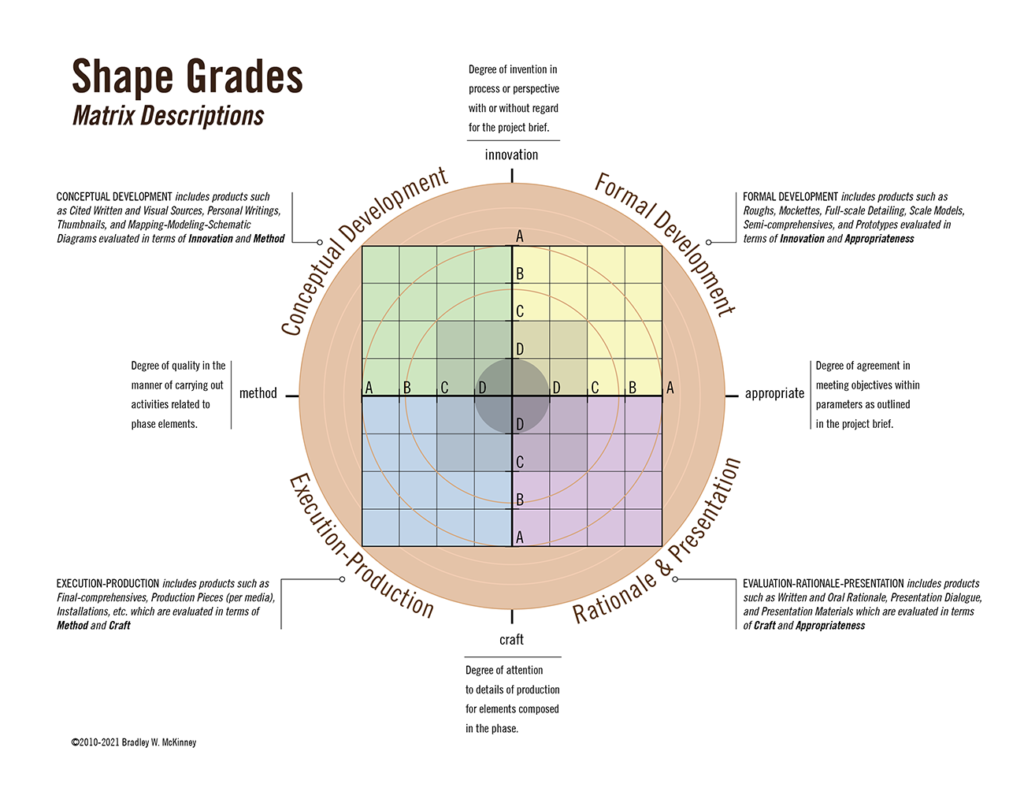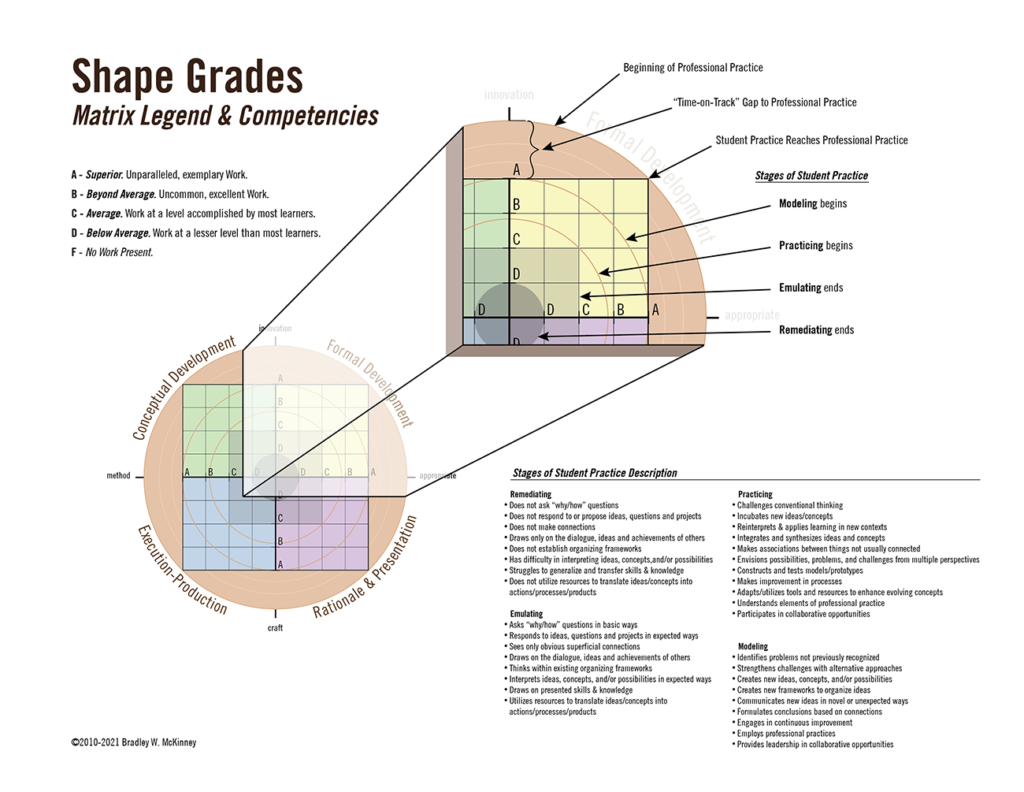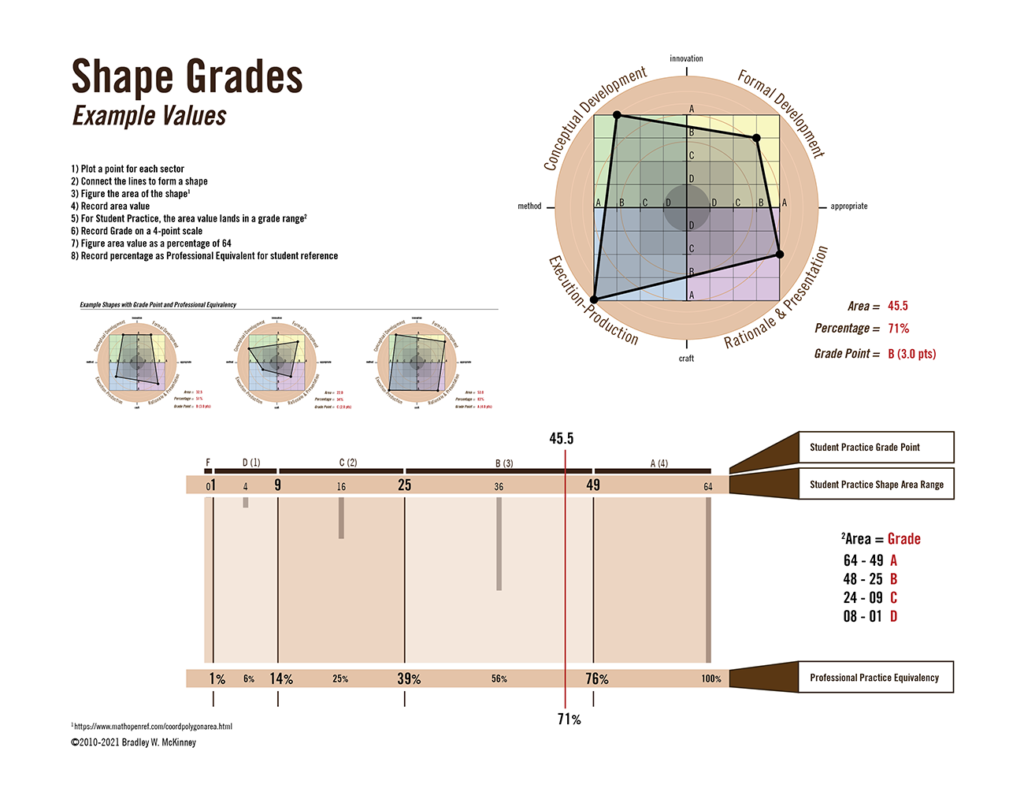Grades are just the worst, wouldn’t you agree? In the realm of design education, it seems to me that grades are generally a poor instrument for providing feedback to the student, or testifying as a record of the learning experience for the transcript. Perhaps the whole enterprise is suspect, although this piece will not address such a critique. Rather, in the institutions I have been fortunate to teach, grades are a requirement. As such, “why” questions are swept aside…because: Why grade? Answer: We must. Therefore, the remaining questions to be raised are “how” to go about grading, such as:
- How does one participate in the grading regime in a way that is meaningful and useful to the student?
- How might grading be shaped into a means of promoting understanding of one’s progress toward readiness for professional practice?
- How might the process draw upon the professional expertise of the facilitator to render a grade value?
- How might grading become a more efficient and even enjoyable process for the person assigning the grades?
There are other questions to examine as well, but for the sake of being concise, these questions most clearly impacted the objectives for developing the Shape Grade system.
Some assumptions that propelled the development of the system include:
- I can’t tell the difference between an 89 and a 90, but I can tell the difference between an “A” and a “B” or a “C.” Likewise I cannot tell the difference between an “A-“ and an “A” and so on. Therefore, pluses and minuses are meaningless for project evaluation.
- I can only draw from the area of knowledge for which I am responsible, in my case Visual Communication Design (IxD, UX, UI, Graphic Design, Environmental Design, etc.)
SPECIAL NOTE: I believe the resulting grading scheme could be meaningful, helpful, efficient, and enjoyable beyond my discipline, but the work to make it so will have to be carried out by experts in those areas of knowledge for which it is to be employed.
- In my understanding of “failure” in education, the only way to do so is neglect. For instance, for one to be absent, or for one’s work to be absent.
- The institutions I have taught at use a 4-point scale for determining GPA based on the letter grades of A, B, C, D, and F from 4 to 0 respectively.
- There is no such thing as “the real world” as in one day a student will reach it…wouldn’t that mean the one a student is living is not real? Still, there is a difference between Professional Practice and Student Practice. Namely, in student practice we preserve the opportunity to fail.
- The faculty administering a project is a representative of the profession and therefore the judgement they render should be related in terms of professional practice as ostensibly it is the student’s overall objective to join the profession as a practicioner.
Now then, the system…
Product Related Evaluation:
Projects in my design courses are evaluated throughout development, by critique presentation and discussion, and a formal response from me as facilitator. Each project is evaluated based on the entire process, not on “final” objects alone. This method of evaluation is consistent with both professional practice and successful schools of design education. Focusing evaluation upon the entire process also promotes “Design Thinking” as the chief aim of programs of the various types of design (Graphic Design, Visual Communication Design, User Experience Design, Interaction Design, etc.). Products and process each bare equal importance in such a scheme. The grading matrix codifies the activity of performing balanced evaluation on both product an process.
The design process itself offers a framework by which to make evaluation. While particular schools of thought may have more or fewer phases, and present them in various iterative orders; however, generally speaking, the design process is understood to have four phases. They are conceptual development, formal development, execution-production, and presentation-rationale-evaluation. Of course, design developments are often non-linear, so the phases are often quite integrated. However, these phases serve as distinctions giving greater clarity to the type of work being done throughout a project’s development. In professional practice, these phases often translate into billing categories. The categories of conceptual development, formal development, execution-production, and presentation-rationale-evaluation. have associated products by which each phase is evidenced and evaluated. Therefore, these phases can be understood as Product Related Evaluation of the product/process dichotomy. The following descriptions clarify the distinctions between each phase. [More information on each of the categories.]
Process Related Evaluation:
The Process Related Evaluation elements stand as the terms by which the product related phases are evaluated. As processes they are the intangibles of design development that give rise to the associated products of Conceptual Development, Formal Development, Execution-Production, and Evaluation-Rationale-Presentation. For purposes of design project evaluation, the process related elements are named method, innovation, craft, and appropriateness. The following descriptions aim to shed light on the meaning and significance of the process elements, but do not attempt to exhaustively define them. [More information on each of the elements.]
How it works:
I started by making a grid with a quadrant for each product category. The grid goes from 0 to 4. The axis of the grid became the process elements by which the adjacent category is evaluated. Next I plot a point in each quadrant category based on the process axis. For instance, Conceptual Development is measured by method and innovation. Once each quadrant is plotted, I connect the points. This renders the Shape Grade for the project.
In the images below, one can see some pretty interesting things emerge in terms of the relationship between student practice and professional practice. The images give further clarification of how the shape grade is converted to a university grading scale as well. The shape and the grid upon which it is rendered offer rich feedback beyond an abstract letter grade. Have a look and see what you think!


